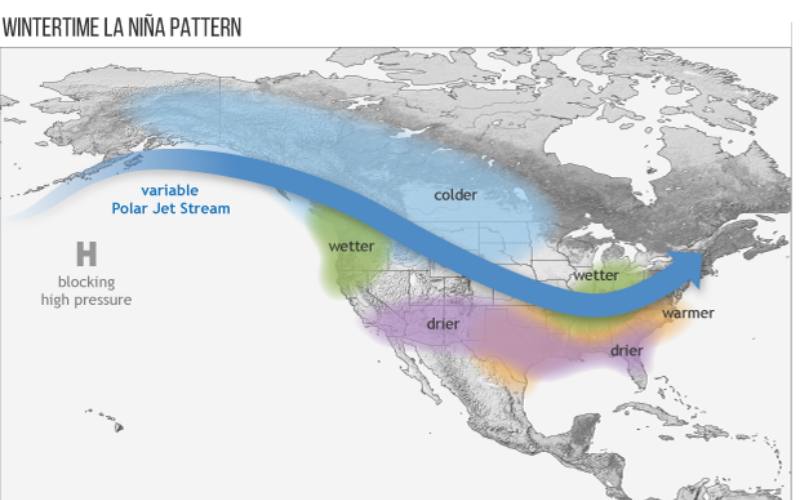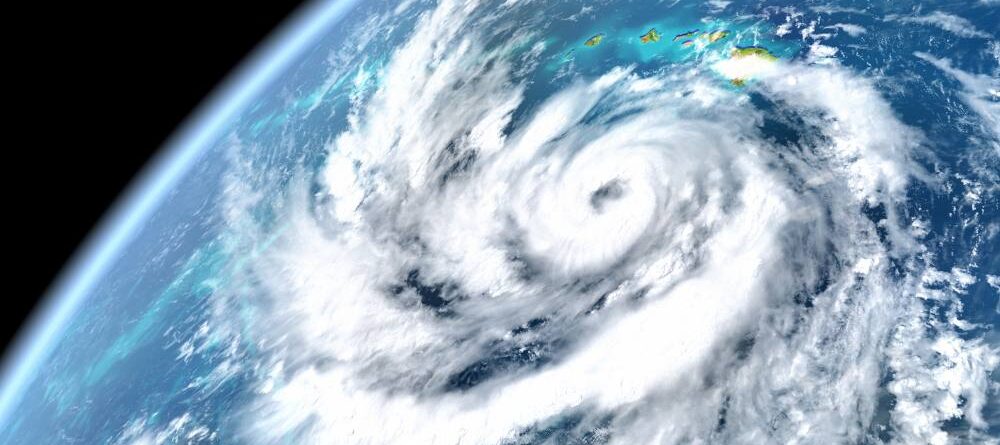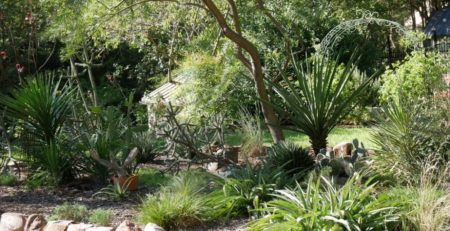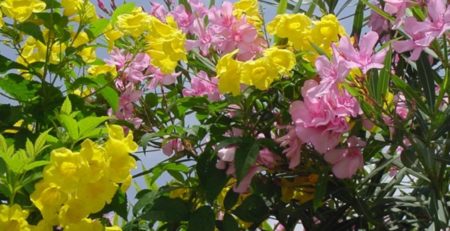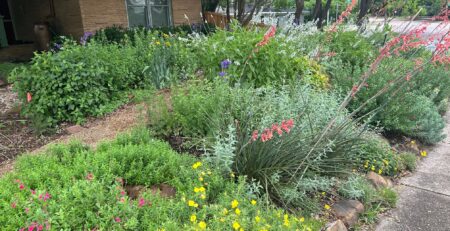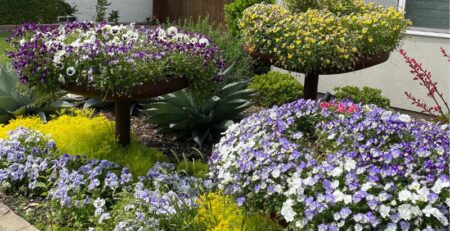La Niña? El Niño? What?
We have all heard our TV weather person talking about La Niña and El Niño. What does it mean to me, the gardener?
Firstly, years ago, Peruvian fishermen recognized a warming of the water, usually about Christmas time, thus the name El Niño, the little boy, or Christ child in Spanish. Scientific discussions of the phenomena started in the 1890’s with exchanges between Geographical Societies. It was first thought that the phenomenon of the warm current noted by the fishermen only applied to South America. It wasn’t until the 1960’s that it was associated with changes throughout the Pacific region and beyond. 1
Cooler than normal weather patterns in the Pacific were subsequently observed and called La Niña, the little girl. El Niño and La Niña are the opposite phases of ENSO (pronounced en-so), which is short for El Niño-Southern Oscillation.2 It is not known what causes El Niño or what the impetus is for the change to a La Niña. It involves the full complexity of ocean-atmospheric interaction on a global scale. It also includes the positions of the mid-latitude jet streams. 1 These fast flowing, high-level winds play a key role in splitting warm and cool air masses and driving storms from the Pacific across the US mainland. Dr Mike McPhaden, a senior research scientist at the US National Oceanic and Atmospheric Administration, said historically El Niños tended to come along every four years or so, and they vary in degree from mild to monster. The really big ones echo planet-wide with extreme weather in the form of droughts, floods, heatwaves, and storms. The world’s hottest year on record so far was 2016, the last strong El Niño. 4 (Remember that El Niño is not alone in affecting weather, we also have climate change effects5 and other fluctuations. And cooler in Texas may mean only 95o, not 105o)
Here in Texas, we have been living in a La Niña pattern (warmer-drier) for the past 3 years. Predictions are that El Niño is going to return by the end of this summer. 3 Is it going to be the normal El Niño pattern, or worse? Generally, El Niño brings cooler and wetter weather to the southern United States with local flooding and a more active tornado season. We might want to plan for veggies and other annuals that can take the wet conditions that El Niño is expected to bring.
Plant selection is important. Some plants will do better with more rain. Herbs generally will love it. Carrots could care less if it’s raining but tomatoes don’t like to get their leaves wet as they are the prima donna of the vegetable world. (They are much happier with drip irrigation and only 1” per week. No more, “but they will love me if I water them every day”). You want them to develop long roots reaching down for moisture. Many problems with tomatoes begin when watered overhead and soil is splashed up on the lower leaves, causing disease. Cucumbers tend to get powdery mildew as do squash, mostly caused by warm humid days. Tie these plants up to a trellis so that air can circulate. Make sure everything is fertilized properly. A strong, well-fed plant resists disease better. Check seed descriptions for “disease resistant” varieties. We are used to mulching our plants deeply in Texas to avoid moisture evaporation. If we go through a rainy spell, pull the mulch away from the plants so the soil can dry out.
Go in for smaller vegetables, varieties that will produce within 50 to 60 days. Pickling cucumbers can be used universally and not just in pickles, and there are other sweet peppers that are smaller and are ready before bell peppers. The longer a plant is in the ground the more likely it will succumb to some disease. Scatter the different types in your plantings. Don’t plant all your peppers/tomatoes in the same place. If something starts looking sketchy, take it out and throw the plant away. Do not compost diseased plants. If you want to replant in that place, choose a different vegetable. Greens will “bolt” if it gets outside their cool comfort zone. If this happens, it’s time to go to something else.
People are incorporating edibles into their flower beds or in pots along with their annuals. It’s easy to attend the local plant sales and pick up 4” pots of vegetables. The nice thing about the plant sales held by Texas Discovery Gardens or Raincatcher’s Garden is they know what varieties grow best in this area. The nice thing about growing in pots is that the pots can be moved around (maybe not easily, so get a hand truck to help). This way, as the sun patterns in your yard vary, or are taken over by shade, the pots can be relocated.
Something to be aware of with large pots: poor drainage! Make sure your pots have large or multiple holes. If you have a pot that quits draining, make sure the holes are not blocked and put gravel or small rocks under it so it’s not flush with the ground. Plants only need about 10” of fertile soil to grow in. Large pots can first be filled with leaves and small sticks. Use good quality potting soil to fill the rest. You can definitely re-use the soil that is in your pots by adding amendments: compost, worm castings, cottonseed meal, and agricultural molasses to encourage beneficial microbes. If you have used sticks and leaves in the bottom of your pot, they will eventually break down leaving more room for additions next planting time.
Farmers have always faced weather-related challenges, but we are lucky to live when scientific forecasting allows us to increase our chance of success. Weather prediction can still be iffy, it is Mother Nature we are dealing with after all. You can try changing the varieties of plants for those that are more disease resistant. Otherwise make sure the environment is optimal: good drainage, good air circulation, and consistent fertilization. Hopefully you will have a winning season during the next El Niño year.
Sources
1 Billy Kessler
Oceanographer
Pacific Marine Environmental Laboratory / NOAA
http://faculty.washington.edu/kessler/occasionally-asked-questions.html#q8
2 Global impacts of El Niño and La Niña
By Rebecca Lindsey
NOAA Climate.gov
https://www.climate.gov/news-features/featured-images/global-impacts-el-ni%C3%B1o-and-la-ni%C3%B1a
Feb 9, 2016
3La Niña is over. Scientists eye ‘rapid’ switch to planet-warming El Niño
Scott Dance
https://www.washingtonpost.com/weather/2023/03/09/la-nina-over-el-nino/
March 9, 2023
4 El Niño 2015/16: A Historical Perspective
https://www.ncei.noaa.gov/access/monitoring/dyk/elnino-2015-2016
5 World could face record temperatures in 2023 as El Niño returns
By Kate Abnett
Reuters 4/20/23
https://www.reuters.com/business/environment/world-could-face-record-temperatures-2023-el-nino-returns-2023-04-20/
Additional Resources:
https://www.ncei.noaa.gov/
https://www.cpc.ncep.noaa.gov/products/precip/CWlink/MJO/enso.shtml
https://www.weather.gov/sto/ENSOinformation
